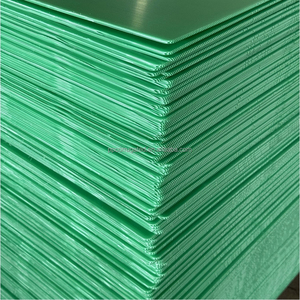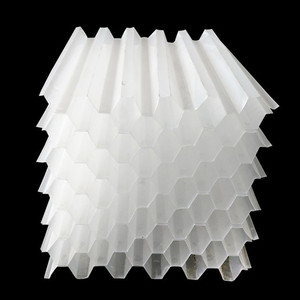
All categories
Featured selections
Trade Assurance
Buyer Central
Help Center
Get the app
Become a supplier

(292 products available)

































Corrugated plates interceptors are solids and oil separation units commonly used in wastewater treatment plants and industries to prevent pollutants from entering water bodies. There are several ways to categorize corrugated plate interceptors.
By Materials
The corrugated plate interceptors are typically made of three materials: fiberglass, thermoplastic, and steel. For instance, fiberglass is plastic reinforced with strong glass fibers. This material offers a potent and resilient option, making it capable of handling various waste products. On the other hand, Thermoplastic materials are formable and fuse well, like polypropylene and HDPE. They provide a flexible and robust alternative, often resistant to chemical reactions, making them suitable for diverse industrial environments. Steel materials are strong, magnetic, and shiny metals composed of carbon and iron. They are ideal for offering structural support and strength.
By Flow Method
The cross-flow interceptor operates with an influent perpendicular to the flow direction. Its compact design suits spaces with limited lengths. In contrast, the parallel flow interceptor aligns the influent parallel to the outlet. It provides efficient separation but requires more installation space.
By Function
Gravity separators work by allowing the influent to enter and settle down. They separate the lighter components, such as oils and greases, from the bottom heavy ones, like sand and sediment, by gravity. Dissolved air flotation separators use micro-bubble flotation to extract contaminants and are suitable for handling high pollutant loads.
By Plate Design
Traditional corrugated plate interceptors utilize parallel plates to achieve sedimentation. Modern versions incorporate diverse geometric patterns. Some employ a cross-hatched design, creating smaller gaps for enhanced separation efficiency. Others utilize a radial pattern with concentrically arranged plates, further optimizing the separation process. Additionally, multilayer structures combine distinct plate materials and configurations to attain superior separation outcomes.
Material:
The construction materials used to build the corrugated plate interceptors, such as stainless steel or carbon steel, determine their durability, corrosion resistance, and overall quality.
Total Volume:
The total volume of a corrugated plate interceptor is the maximum amount of wastewater it can contain. This is usually measured in liters or gallons and is directly related to the size and dimensions of the interceptor.
Number of Plates:
A corrugated plate interceptor typically consists of multiple corrugated plates. The effectiveness and efficiency of the interceptor can be affected by the number of these plates.
Slant Angle of Plates:
The corrugated plates in an interceptor are usually slanted, which assists in the separation of oil and grease from the wastewater. The slant angle of the plates can influence the interceptors' separation efficiency and overall performance.
Regular Inspections:
One is to inspect the condition of the interceptor regularly, checking for signs of damage or corrosion. This can ensure the structure's safety and operational efficiency.
Cleaning:
This involves removing the waste and contaminants that have accumulated in the interceptor over time. Carrying out regular cleaning can prevent blockages and promote the smooth flow of wastewater.
Plate Maintenance:
The plates in a corrugated plate interceptor are its core components. Regular maintenance should include cleaning and inspecting the plates, ensuring they are not blocked or damaged, and promptly addressing any issues.
Pump Maintenance:
For those interceptors equipped with pumps, routine maintenance of the pumps is also necessary. Regularly inspecting and servicing the pumps helps ensure good operating conditions and prevents faults and breakdowns.
Leak Check:
Over time, factors such as aging or damage can cause leaks in the interceptor. Regular checks for leaks allow for the early detection and rectification of any leakage issues, thus preventing wastewater from leaking out.
The corrugated plate interceptor has various applications in the oil, water, and wastewater treatment industries. Below are some usage scenarios for this device:
Separation of oil from wastewater in treatment plants
A municipal wastewater treatment plant can install this interceptor in the influent line before the primary treatment tank. It will help remove the dispersed oil in the sewage before biological treatments, enabling the facility to meet discharge standards and enhance the following treatment stages.
Pre-treatment in industrial facilities
Many industries produce oily wastewater from manufacturing processes, such as food processing, automotive, and machine shops. Therefore, these facilities can use the corrugated plate interceptor as a pre-treatment unit to separate and collect oil before the wastewater undergoes further treatment. This action will help protect the subsequent treatment equipment.
Landfills and stormwater runoff management
Lagoon settling ponds at landfills collect leachate and stormwater runoff. Using a corrugated plate interceptor can help extract oil from the runoff and reduce the concentration of pollutants entering the lagoon.
Oil separation from vehicle service stations
Motor vehicle service stations often have oily water from vehicle maintenance operations. Installing a corrugated plate interceptor in the station's drainage system can help separate the oil and prevent it from contaminating the groundwater or the municipal sewer system.
Marine spill management
In the case of an oil spill from a tanker or leak from a pipeline into the ocean, corrugated plate interceptors can be useful in averting further damage. They can be part of the emergency response equipment to manage the spill and prevent the oil from reaching the shoreline.
Retention ponds and swales
A gritted swale or shallow, vegetated channel that allows water to percolate through soil can accumulate oil and greases. A corrugated plate interceptor can be used at the outlet of the swale to trap the oil before the clean water drains away.
When buying a corrugated plate interceptor, buyers should consider several things to ensure the correct selection. They should research the application to understand the specific needs and requirements of the application where the interceptor will be used, which includes analyzing factors like the type of liquid or material to be filtered, the flow rate, and any particular spatial constraints or technical requirements of the installation site.
They should also identify the disposal method for the separated substances after passing through the interceptor, considering whether the buyer has access to a waste disposal facility or needs a transportable solution. Afterward, they can proceed to evaluate the dispo. They should evaluate potential interceptors based on the factors determined by the previous steps, paying attention to aspects such as filtering efficiency, plate design, maintenance requirements, and compatibility with the specific application.
It’s advisable for buyers to consult with experienced professionals who can provide tailored advice based on the particular situation and help to choose the most suitable corrugated plate interceptor. If applicable, buyers should also consider the costs associated with the interceptor, including purchase, installation, and maintenance expenses, and budget constraints to ensure a financially feasible solution.
Q1: Why should someone install a corrugated plate interceptor in a drainage system?
A1: Investing in a corrugated plate interceptor is an effective way to protect downstream water quality and aquatic life from potential harm posed by the accidental release of pollutants into the stormwater.
Q2: How does a corrugated plate separator work?
A2: When water flows through the corrugated plates, the change in flow direction and velocity causes the oil to separate from the water. It then floats onto the surface of the water where it forms an oil slick. The water, now free from oil, exits the interceptor through a designated outlet.
Q3: How often does a corrugated plate interceptor need to be cleaned?
A3: The frequency of cleaning depends on various factors such as the amount and type of pollutants entering the interceptor, the size of the interceptor, and local regulations.
Q4: What is the expected lifespan of a corrugated plate interceptor?
A4: With proper maintenance and periodic cleaning, these interceptors can have a long lifespan, typically ranging from 10 to 30 years or more.
Q5: Are corrugated plate interceptors effective in removing all types of hydrocarbons?
A5: While corrugated plate interceptors are highly effective at removing a wide range of hydrocarbons, some complex or emulsified hydrocarbons may require advanced treatment methods.